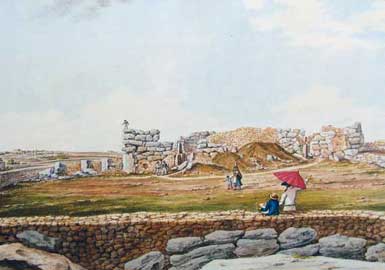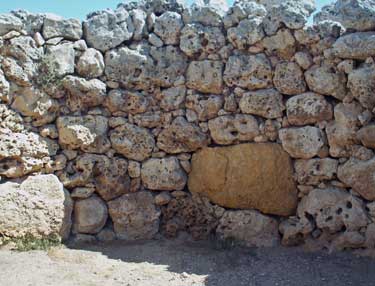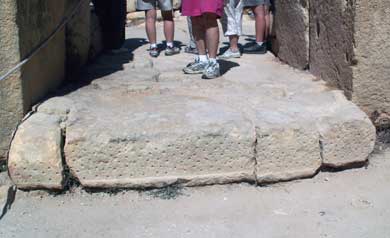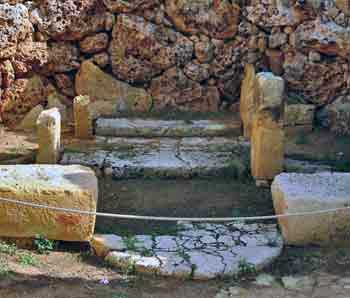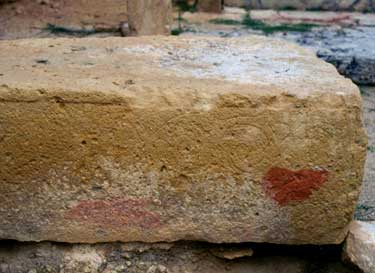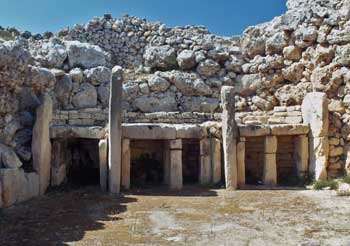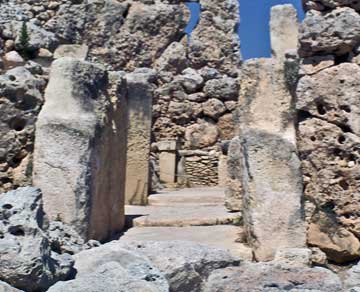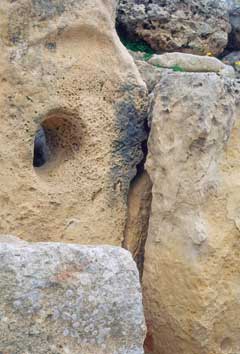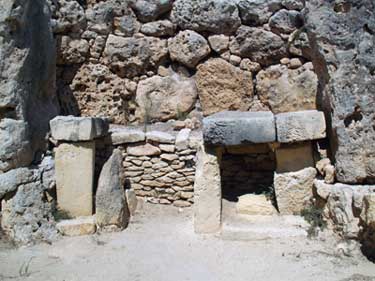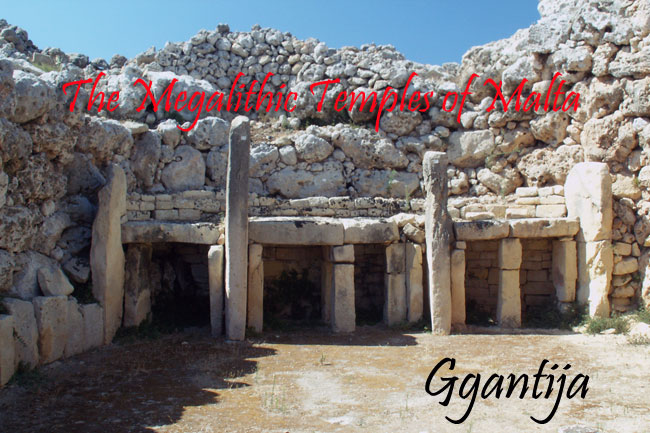
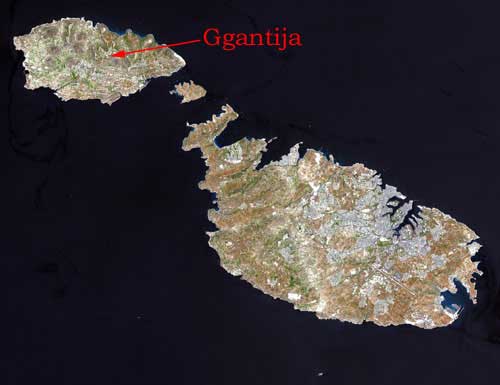
According to folklore, the temples at Ggantija on the island of Gozo were built by a giantess (hence the name). The site was a regular stop on the European ‘Grand Tour’ and has been described and illustrated by numerous antiquarians. Unfortunately, the site has never been properly excavated. It was partially cleared in the 1820’s by Colonel John Otto Bayer, the British lieutenant governor, but the only record is a series of watercolours by Charles de Brochtorff done shortly afterwards. The fullest descriptions of the remains are by Alberto de la Mamora, published in 1836, and by Albert Mayr, published in 1901. The latest work on the site was done by Charles Zammit who put in a few trenches in the 1930’s.
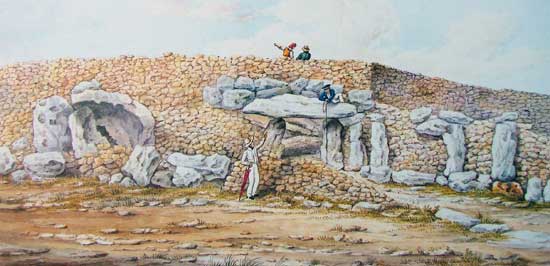
Enclosure Wall by Charles de Brocktorff
The complex is made up of two temples, which sit side by side on the same axis and sharing a common forecourt that sat on an artificial terrace. The retaining wall survives but has been badly damaged over the years. Brocktorff’s painting shows a number of large uprights embedded in the wall and what appears to be a trilithon and a passage leading to the forecourt (where the two men are standing).
The Temples
The larger of the two temples, Ggantija South, is five-apse temple and was built sometime around 3500 BC during the Ggantija phase (the typical pottery of the period was first identified here). John Evans believed that the original structure was a three-apse temple very similar to that at Skorba in appearance. Substantial renovations took place later in the Ggantija or the beginning of the Tarxien Period (ca. 3100 BC). These involved the dismantlement of most of the northern part of the external wall to make room for a new, four-apse temple, Ggantija North. Evans believed that the expansion of Ggantija South occurred at the same time or just after. He noted that the outer pair of apses were unusually small and thought that this may have been because so much space was taken up by the new temple.
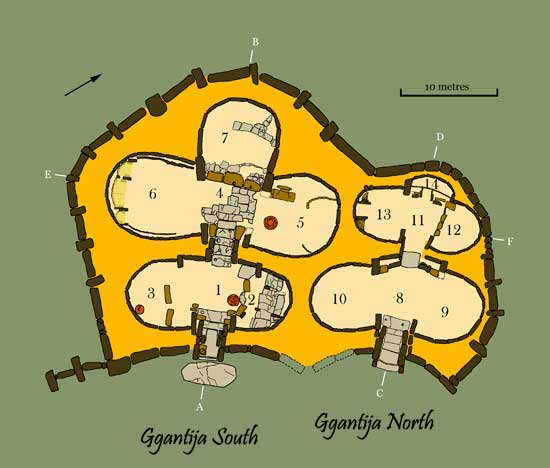
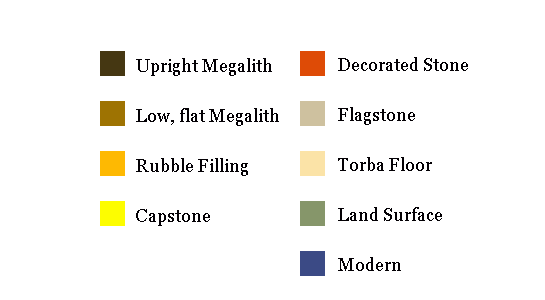
The temples share the same forecourt but each has its own concave façade. Unfortunately the junction between them proved unstable and has since collapsed—the blocks are lying there. Where it is reasonably well-preserved, the façade consists of upright slabs at the base supporting courses of roughly shaped stone blocks. The buildings face onto a level, terraced forecourt about 35 metres 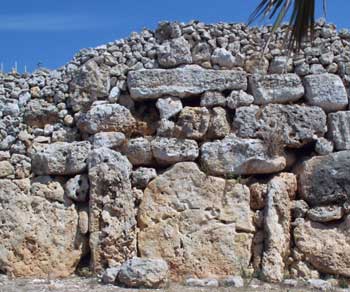 across at its widest. This platform was held in place by a retaining wall of large, unworked blocks some of which can be seen today.
across at its widest. This platform was held in place by a retaining wall of large, unworked blocks some of which can be seen today.
The interior walls of both temples were made of rough boulders of various sizes piled on top of one another. Only in the passageways and at the corners of the apses is dressed stone used for structural purposes. The construction of the common exterior wall is different for each building—not surprising, if they were built at different times. Around the southern temple (left) it consists, at its lower level, of broad slabs alternating with narrow pillars set at right angles to them and projecting slightly outwards. The stones are massive—the largest is 5.7 metres across, 3.8 metres tall and weighs approximately 50 tonnes. The stretch of wall around the northern temple, on the other hand, is generally made out of smaller stones and the scheme of alternating broad slabs and pillars disappears at the back of the building.
Ggantija South
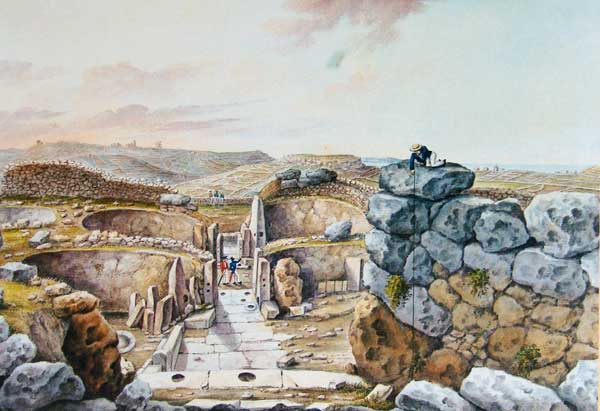
Ggantija South from the rear of the Temple. Charles de Brocktorff
The entrance to Ggantija South was suitably monumental—the façade of roughly hewn Coralline blocks still stands to a height of over 7 metres and was probably closer to 10 metres high originally. No lintel was found but it was undoubtedly a typical trilithon. There is an enormous stone threshold, 5.66 metres long, 2.4 metres wide and 25 centimetres thick, immediately in front of the doorway—now broken into a number of pieces. The front of the slab was carefully trimmed and decorated with a pattern of pitted holes. The 1933 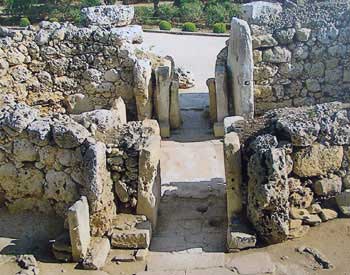 excavations revealed an inverted offering bowl containing 158 seashells along with the horn core of a bull or cow.
excavations revealed an inverted offering bowl containing 158 seashells along with the horn core of a bull or cow.
The initial passageway is a little over 2 metres across and was lined with six tall Globigerina orthostats. At the inner end there was a pair of even taller uprights set outside the others and overlapping them. These inner stones have been drilled with bar holes, four on each side. Inside this setting are four smaller slabs, about 1.8 metres high, which narrowed the width of the passage to about 1.35 metres. The passage was paved with three large flagstones, each stepped slightly above the previous one. The outermost flagstone was T-shaped to accommodate the inner range of orthostats and the others were carved to hold small, cubical blocks that had been drilled with patterns of dots. A conical hole had been bored right through the last paving stone at the left-hand end as you enter the inner court. It looks very much like the socket for a doorpost. Nowadays visitor traffic is such that a wooden walkway now covers the original pavement.
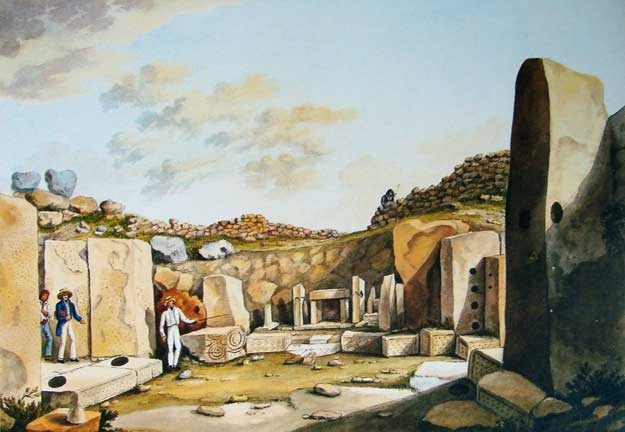
Ggantija South. Apse 2. Charles de Brocktorff
The entrance passage is part of a longer corridor that leads through a pair of small courtyards to a large terminal apse at the rear of the building. The floor is paved for much of its length and rises steadily as it goes. The same effect is noticeable in Egyptian temples where it is used to heighten the sense of mystery and awe but in this case it may have been simply for purposes of drainage (if one assumes that the paved areas were open to the elements) or it may simply reflect the natural slope of the hill. The first courtyard [1] is flanked by a pair of apses whose layout is remarkably 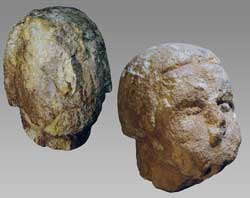 similar to that of the outer apses at Tarxien South. In this case, the right-hand apse [2] was the one that was elaborately furnished. There was a line of stone blocks interrupted by an opening with a semi-circular threshold that looks much the same as the arrangement in Apse 3 at Tarxien. In both cases the blocks bore spiral decoration—although at Ggantija the reliefs are so badly worn that they are scarcely visible today. The Brochtorff painting (above) shows a trilithon altar flanked by orthostats—similar to the arrangement at the rear of Tarxien South—but only a few broken fragments survive today. Two battered limestone heads belonging to round-faced women (right) with cropped hair were found in front of the niche. The hairstyle is similar to that found on figurines and statuettes found on other sites and they were probably part of a composite figure, perhaps made of wood although a some of the seated figures from other sites are headless and have a slot for an attachment.
similar to that of the outer apses at Tarxien South. In this case, the right-hand apse [2] was the one that was elaborately furnished. There was a line of stone blocks interrupted by an opening with a semi-circular threshold that looks much the same as the arrangement in Apse 3 at Tarxien. In both cases the blocks bore spiral decoration—although at Ggantija the reliefs are so badly worn that they are scarcely visible today. The Brochtorff painting (above) shows a trilithon altar flanked by orthostats—similar to the arrangement at the rear of Tarxien South—but only a few broken fragments survive today. Two battered limestone heads belonging to round-faced women (right) with cropped hair were found in front of the niche. The hairstyle is similar to that found on figurines and statuettes found on other sites and they were probably part of a composite figure, perhaps made of wood although a some of the seated figures from other sites are headless and have a slot for an attachment.
Apart from a couple of recumbent slabs and a circular stone with a pair of holes bored through it, Apse 3 is now devoid of any sort of furnishings. However, when the site was re-examined in 1933 the excavators removed a compacted 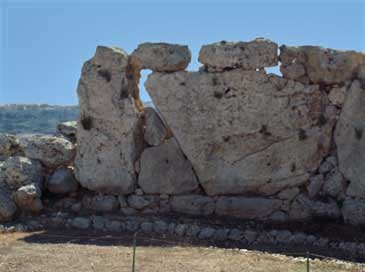 mass of clay that Bayer assumed was the remains of an altar. It turned out to be nothing more than debris but the wall behind it showed clear evidence of having been plastered. The rough stone walls of this room (and presumably the others, as well) were packed with clay, which was then smoothed and covered with a coat of lime plaster about 5mm thick. Traces of red paint were found on the plaster but not enough evidence has survived to reconstruct the designs. The curvilinear and spiral patterns on the ceilings at the Hypogeum at Hal Saflieni suggest some possibilities, however.
mass of clay that Bayer assumed was the remains of an altar. It turned out to be nothing more than debris but the wall behind it showed clear evidence of having been plastered. The rough stone walls of this room (and presumably the others, as well) were packed with clay, which was then smoothed and covered with a coat of lime plaster about 5mm thick. Traces of red paint were found on the plaster but not enough evidence has survived to reconstruct the designs. The curvilinear and spiral patterns on the ceilings at the Hypogeum at Hal Saflieni suggest some possibilities, however.
A short, paved passage leads to a small inner court [4] and the three apses that make up the rear of the temple. There was a raised threshold slab with pitted decoration at the entrance to the corridor, which lined with orthostats. These probably supported a series of lintels but no trace of these has been found. The paving slabs had been drilled with a series of four ‘libation holes’ similar to those found at Skorba—reinforcing Evans’ notion of an original three-apse temple.
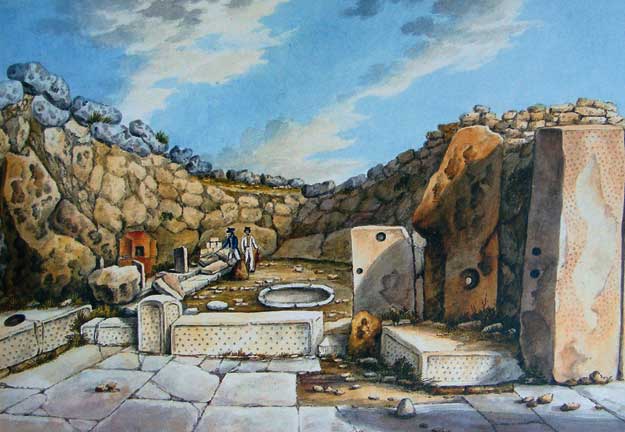
Ggantija South. View of Apse 5 by Charles de Brocktorff
Apse 5, on the right as you enter the court, contained a line of low stone blocks, decorated with patterns of pitted dots when Brochtorff did his sketch of it. At its eastern end was an upright slab 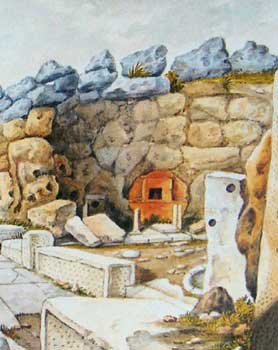 with a round hole near the top and another further down, near the left-hand edge. Just inside the room is a circular stone hearth about 1 metre in diameter—similar to one in Tarxien Central. There was also a flat slab about 1.35 metres long and 0.6 metres across that had a relief of a snake running along one edge. Unfortunately, it does not appear to have been found in situ. Brochtorff also shows what appears to be a hollow altar somewhat similar to the one that contained the bones and flint knives at Tarxien South. A ledge was cut about halfway up the face of a large slab of globigerina and the surface above that was cut back so as to leave a raised rectangular frame for a square opening. In front of it was a setting of uprights resting on a horizontal slab, which may have been the lower part of an offering table. We will never know for sure because, apart from the hearth and the slab with the relief (now in the Museum of Gozo in the Casa Bondin), none of this furniture has survived. Two curved settings of smaller stones run out from the rear of the apse, enclosing a slightly raised torba surface.
with a round hole near the top and another further down, near the left-hand edge. Just inside the room is a circular stone hearth about 1 metre in diameter—similar to one in Tarxien Central. There was also a flat slab about 1.35 metres long and 0.6 metres across that had a relief of a snake running along one edge. Unfortunately, it does not appear to have been found in situ. Brochtorff also shows what appears to be a hollow altar somewhat similar to the one that contained the bones and flint knives at Tarxien South. A ledge was cut about halfway up the face of a large slab of globigerina and the surface above that was cut back so as to leave a raised rectangular frame for a square opening. In front of it was a setting of uprights resting on a horizontal slab, which may have been the lower part of an offering table. We will never know for sure because, apart from the hearth and the slab with the relief (now in the Museum of Gozo in the Casa Bondin), none of this furniture has survived. Two curved settings of smaller stones run out from the rear of the apse, enclosing a slightly raised torba surface.
De Brochtorff depicts a series of altars in Apse 6—three trilithon niches within a setting of four taller orthostats. These had been almost totally destroyed by 1900 but have since been repaired and reconstructed. The niches are of different sizes, with the largest in the centre. They are roughly the same height (about 1 metre), each consisting of a capstone supported by a pair of uprights and a back wall of dressed stone blocks. The horizontal slab of the central niche is cracked and is supported by a central pillar, presumably added in more recent times. Much the same thing seems to have happened to the right-hand niche as well. On either side of the central niche is a tall pillar (2.5 and 2 metres high respectively) and there are shorter uprights at either end. On each side of the setting of niches is a low wall set in front of the wall of the apse proper. The one on the right is only about 25cm high but that on the left is made out of thin slabs about 75cm high.
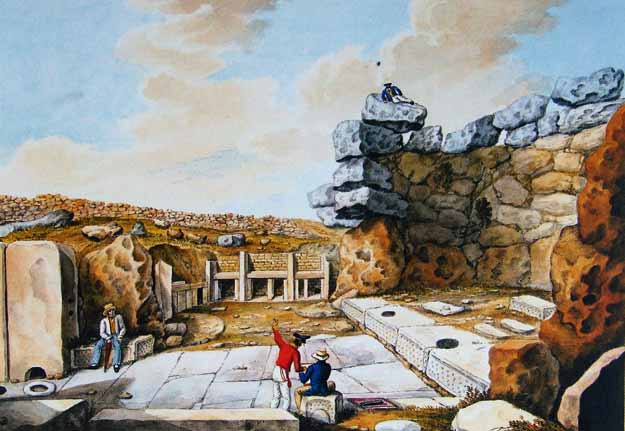
View of Apses 6 (bkgd) and 7 (right) and Court 4 (frgd) by Charles de Brocktorff
Apse 7, the terminal apse, is a very imposing structure with walls nearly 5.5 metres above ground level and about 10 metres higher than the entrance to the temple. They were made of rough boulders and curve inwards towards the top The floor of the apse is raised and separated from the rest of the temple by a kerb of three stone megaliths 60cm high, decorated with a pattern of deeply drilled holes. Two of them have been bored right through. Apart from a low kerb about 30cm high near the back of the room, little was found in the way of features.
Ggantija North
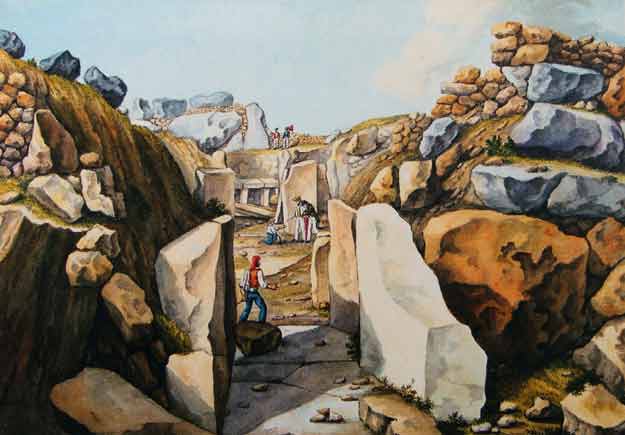
Entrance to Ggantija North by Charles de Brocktorff
The entrance to Ggantija North is similar to that of its neighbour but somewhat shorter. There is a threshold out front flanked by a pair of low blocks of stone. The passageway is flanked by two pairs of slabs about 1.9 metres high (although the outer pair have been cut down at the front, possibly to facilitate the removal of the capstone at a later date) and there is a third, even taller pair flanking the inner doorway and marking the ends of the two apses. Bar holes and shallow grooves in the uprights indicate that there was a secure door here. There are holes (for tethering ropes) in the third pavement slab and a pair of circular hollows near the outside edge of the last one.
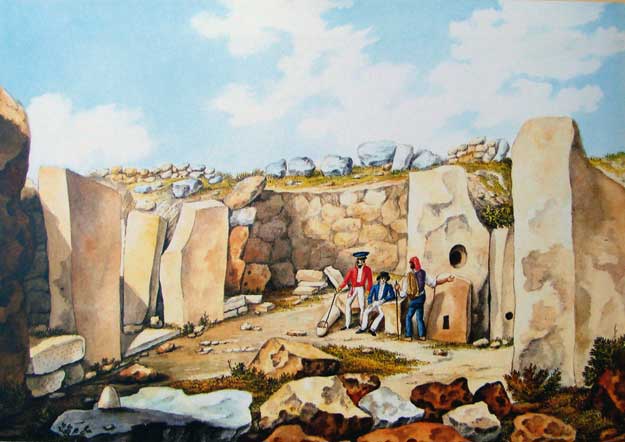
Ggantija North. View of Court 8 & Apse 9 by Charles de Brocktorff
The inner court [8] and two flanking apses [9 & 10] contained little of interest apart from a conical stone that appears in one of Brochtorff’s sketches (the man in the red jacket is resting his stick on it) that may have been a baetyl. There is an unusual setting of stones on either side of the entrance to the passage that leads to the inner apses. Next to the terminal stone of each apse is a horizontal slab, probably an altar, resting on a course of smaller stones. Brochtorff shows drilled decoration on both altars and their supports. Next to each altar was another stone upright, set with its broad side facing into the court.
The corridor leading to the rear of the temple was more or less a scaled-down version of the entrance passage. Originally, there were three pairs of uprights—two on each side of the passage and another pair of pillars overlapping them and framing the inner door. However, apart from the pillars, only the stones on the left side have survived and only one of the original paving slabs. Apse 12 is separated from Court 11 by a low wall 60cm high consisting of three courses of blocks with three long slabs on top. A considerable amount of bones and potsherds were found in the area behind the wall under a deposit of ashes. At the back of Apse 13 there are the remains of a table niche, consisting of two pairs of uprights flanked by a pair of low slabs.
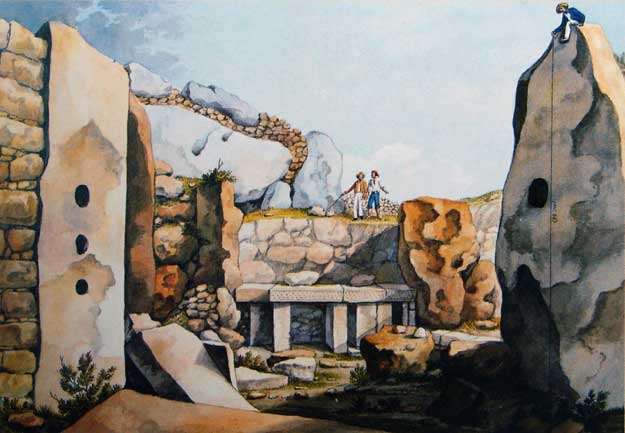
Ggantija North. Apse 10 by Charles de Brocktorff
The innermost part of the temple [14] is almost entirely taken up by the remains of a table niche 1.4 metres high. The horizontal slab is supported by a pair of uprights, which were themselves flanked by another pair of uprights set with their broad sides facing into the court. These last two were each braced by to smaller blocks set at their base. The space behind was covered by horizontal slabs that rest partly on the uprights and partly on a low wall of small stones. This wall was carried upwards using larger stones so that it blocked the area behind the niche. In Brochtorff’s sketch the outer face of the horizontal slabs was decorated drilled holes but no trace of these have survived.

